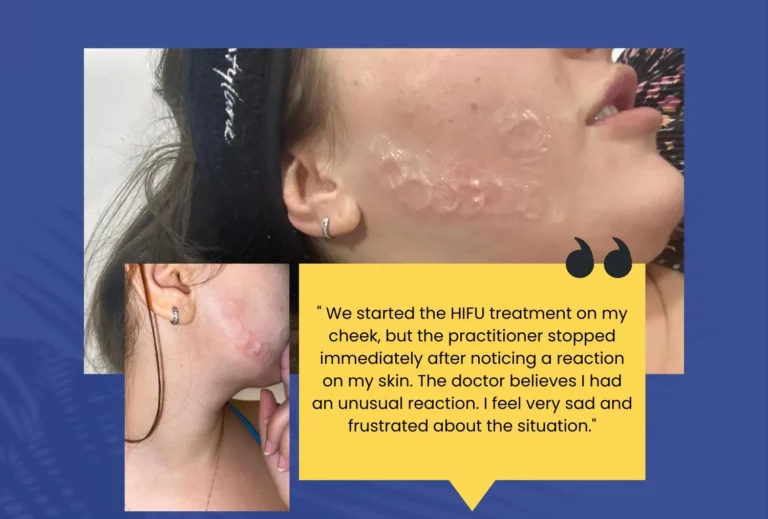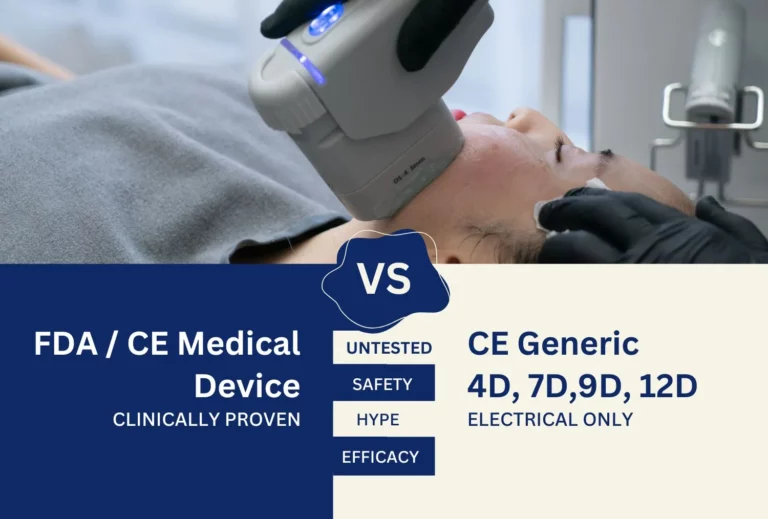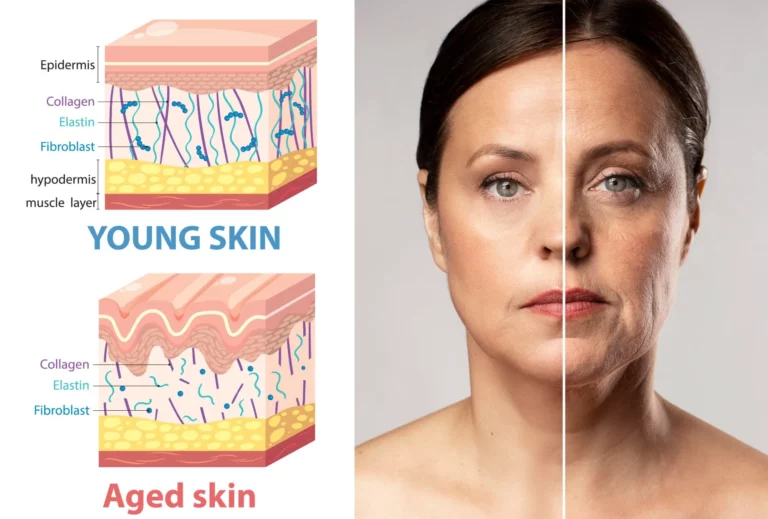1. Chronology and origin of the method
HIFU technology is not new, it has been used successfully in medicine for years, including in urology and oncology. Its application in aesthetic gynecology has been developing over the last decade.
Although it is not possible to specify an exact date of introduction, the boom in popularity and commercialization of vaginal HIFU, along with other energy devices (lasers and RF), is observed after 2014-2015 This is the period in which the market begins to actively offer non-surgical solutions for vaginal rejuvenation.
2. Indications for applying the HIFU method
Vaginal HIFU targets issues that arise as a result of aging, childbirth, and hormonal changes (e.g. menopause). This method promises to address the following underlying conditions:
- Vaginal laxity: A common condition after normal childbirth that can reduce sexual satisfaction.
- Mild stress urinary incontinence (SUI): Leakage of urine during physical exertion (coughing, sneezing, laughing) due to weakening of the pelvic floor muscles.
- Symptoms of atrophy: Relieving vaginal dryness, irritation and pain during intercourse (Dyspareunia) associated with hormonal changes.
3. Main manufacturers and market trend
Since HIFU technology does not require a patent for the principle itself, many companies around the world offer devices with vaginal tips. The market is dominated by manufacturers who offer multifunctional and accessible platforms.
| Manufacturer/Model | Origin | Focus |
| Multifunctional 7D/9D HIFU devices | China | Widely available devices that include vaginal modules. These devices are of variable quality and often lack in-depth clinical data. |
| Ultra Vera | South Korea (Hironic) | One of the first specialized HIFU devices, often cited in early studies. |
| Feminine HIFU | South America (Sveltia) | Developed specifically for aesthetic gynecology. |
The promise of the method: The main promise that manufacturers and clinics make is non-surgical "rejuvenation" of the vaginal tissue, achieved by stimulating the collagen and elastin, leading to tightening and functional improvement with minimal downtime and recovery period.
Despite these promises, it is critically important to emphasize that these indications have not been unconditionally approved by regulatory authorities such as the FDA, which will be discussed in detail in the following sections.
4. Performing vaginal HIFU. Equipment and requirements for the doctor
The vaginal HIFU procedure is energy-based therapy, which requires a high degree of precision. Vaginal HIFU is performed with a specialized HIFU device, which differs from those for face and body lifting mainly in its vaginal tip (cartridge).
- Specialized tip: The tip is designed to be inserted into the vaginal canal and emit the ultrasonic energy into roundabout around the vaginal wall.
- Working principle: The tip is positioned precisely using different depths of focus – usually 3.0mm (for the mucous membrane) and 4.5 mm (for the muscle layer).
- Execution: The procedure usually lasts between 20 and 40 minutesBecause it is non-invasive, no anesthesia is required, and the patient may feel a slight warming or tingling sensation. There is no recovery period required.
Requirements: Professional responsibility
As technology creates controlled thermal damage in the deep tissue layers, the qualification of the specialist is the main guarantor of safetyImproper application can directly lead to the serious risks indicated by the FDA (burns, scars, chronic pain).
| Requirement | Role and argument |
| Specialized doctor | The procedure should be carried out only by a qualified doctor – gynecologist or licensed aesthetic medicine doctor with specialized training. |
| Anatomical knowledge | The gynecologist has a thorough knowledge of the anatomy of the pelvic floor, which is critical for avoiding harm of the urethra, bladder and rectum. |
| Training with the device | The contractor must possess current certificate for working with the specific model of HIFU device and its vaginal modules. |
| Individual assessment | The doctor is responsible for assessing individual suitability the patient, to rule out contraindications (infections, active atrophy) and to adapts the parameters of energy to the state of the tissue. |
Although HIFU is a non-invasive procedure, its application is medical certificatePatients should avoid centers that offer the procedure performed by non-medical personnel, as this directly violates professional standards and compromises safety.
5. Professional control and accessibility
Why is HIFU applied by beauticians, while other technologies require medical personnel??
Technologies such as CO2 lasers, Erbium YAG lasers, Radio Frequency (RF) and PRP injections are considered safe to use only by a medical professional (doctor or nurse).
Unlike them, HIFU (High Intensity Focused Ultrasound) can be applied by beauticians (beauty therapists), often with minimal training in a field in which they have no prior experience.
Here is an explanation for this contrast:
A. Availability and cost of HIFU
The main reason for the wider application of HIFU by non-medical personnel is rooted in financial and practical factors:
• Low initial cost and easy accessibilityThe popularity of HIFU is due to its significantly lower initial price of the device compared to other technologies and its easy accessibility for practitioners.
• Marketing and revenue growthThis accessibility makes it attractive to cosmetic clinics that want to take advantage of market trends and increase their revenues.
B. Why do other technologies require medical personnel?
Other technologies, particularly lasers and radiofrequency (RF) devices, require a high degree of medical expertise due to the potential risks and the need for accurate diagnosis and control of the energy:
• Lack of standardization and warnings from the FDA: In July 2018, the U.S. Food and Drug Administration (FDA) issued a public warning regarding the use of energy-based devices (EBDs) for vaginal rejuvenation or cosmetic procedures, emphasizing that has not approved their use for any specific gynecological indicationsThe FDA has expressed concern about uncontrolled application of lasers and other ECUs by medical professionals and non-medical professionals without clear medical indications.
• Risk of complications: The FDA noted that there have been reports serious complications, including vaginal burns, scarring, pain during intercourse, and chronic pain.
• Depth of penetration and mechanism of action: Radiofrequency devices deliver energy to the deeper connective tissue on the vaginal wall, while the laser devices deliver energy, creating consistent microtraumasHIFU also reaches deep tissue layers (such as SMAS), but other methods such as lasers work mostly at the surface level.
• Need for expertise: The lack of standardized criteria for patient selection and training makes the need for qualified medical personnel (who are familiar with anatomy and pathology) necessary. primary.
6. Clinical effectiveness and reliability
The effectiveness of HIFU has been evaluated in several surveys that use mostly subjective sensations, and long-term safety has not been proven:
• The results are recorded by self-reported questionnaire (self-assessment), which introduces subjective biasThe study no control group.
• These data support the mechanism of action (neocollagenesis), but do not replace the lack of RCTs (Randomized Controlled Trials).
• Small sample and lack of a control group are major limitations. Potential bias in the selection.
7. Opinions on the safety of HIFU
Official warnings and statements
The scientific community, represented by leading urogynecological societies, does not support the routine use of HIFU without more evidence.
- FDA Warning (2018): The U.S. Food and Drug Administration (FDA) has issued a public warning that it has not approved HIFU or other EBUs. for any specific gynecological indications such as symptoms of menopause, vaginal laxity or UI.
- AUGS (2022): The AUGS (American Urogynecological Society) clinical statement notes that lack of evidence is the reason why many statements about EBUs (energy-based devices) have not reached consensus.
- Long-term side effects: There are concerns that HIFU concentrates a significant amount of energy on the basal lamina of the epithelium, which may lead to disruption of the main network of the vaginal tissue. In the long term, this can lead to deterioration of the epithelium, potentially ending with prolapse of vaginal tissue.
- Medical evaluation requirement: Even when HIFU is applied, consultation with a sexual health specialistIn specialized clinics, vaginal HIFU treatment is performed by obstetrician-gynecologist, and it is emphasized that the procedure requires responsibility, technical training and professional ethics.
Categorical conclusion: Experts recommend any energy-based treatment, including HIFU, to be performed with in-depth knowledge of the equipment and within the the legal and ethical boundaries of the profession. FDA did not approve EBU for specific gynecological indications, and the long-term consequences are unknownThe practice of HIFU being performed by cosmetic specialists (with minimal training) can lead to hidden consequences for patients who became aware years later.
Sources used to create the article on vaginal rejuvenation using HIFU and energy-based devices:
| Author(s) / Research topic / Report | Link / Quote |
|---|---|
| 1. US Food and Drug Administration (FDA) | |
| FDA warns against use of energy based devices to perform vaginal 'rejuvenation' or vaginal cosmetic procedures: FDA safety communication. (Public warning dated July 30, 2018, highlighting that the FDA did not approve EBU for specific gynecological indications such as vaginal laxity, urogenital syndrome of menopause (UGMS) or sexual function, and warns about serious complications, including vaginal burns, scars, and chronic pain) | www.prnewswire.com www.moph.gov.lb |
| 2. American Urogynecologic Society (AUGS) | |
| AUGS update: Clinical consensus statement on vaginal energy-based devices (Consensus Report, Updated 2022, on the Use of EBUs and FDA Warnings) | Urogynecology (Hagerstown). 2022;28(10):633-648. www.augs.org |
| 3. International Society for the Study of Vulvovaginal Disease (ISSVD) / International Continence Society (ICS) | |
| ISSVD/ICS comments on the FDA communication on the use of energy-based devices to perform vaginal 'rejuvenation' (The leading companies fully support the FDA warning and recommend against the routine use of laser and RF outside of the well-designed clinical trials). | ISSVD/ICS support FDA warning (2018) https://pmc.ncbi.nlm.nih.gov/ |
| 4. Jusleen Ahluwalia, Mathew M Avram, Arisa E Ortiz | |
| Lasers and energy-based devices marketed for vaginal rejuvenation: A cross-sectional analysis of the MAUDE database (Analysis of the FDA Adverse Event Database (MAUDE) which found the pain (vulva, bladder, urethral) such as the most common adverse reaction. | Analysis of adverse events in the MAUDE database (2015-2019) https://pubmed.ncbi.nlm.nih.gov/ |
| 5. Harriet Moxon, RN (Institute of Medical Physics) | |
| Vaginal Rejuvenation: Unmasking the Dark Side of HIFU and Its Long-Term Repercussions (Analysis of the risks of HIFU, including destruction of the basal lamina and potential prolapse, as well as the lack of medical supervision) | July 28, 2025 (Institute of Medical Physics Knowledge Base) |
| 6. Rania Ali Elrashidy, MD, Msc. | |
| High Intensity Focal Ultrasound (HIFU) for Management of Vaginal Laxity with Impact on Sexual Satisfaction (Retrospective evaluation of the effectiveness and safety of HIFU for vaginal laxity) | International Journal of Scientific Development and Research, 7, 308-311. (December 2022) |
| 7. Moleiro, D., Ruiz-Silva, C, Sobral JL, et al. | |
| Femme Lifting Protocol: Personalized Application of Introductory Microfocused Ultrasound in the Treatment of Vaginal Sagging (Protocol for personalized HIFU application requiring assessment of sagging level to optimize energy parameters) | IOSR Journal of Dental and Medical Sciences, Volume 24, Issue 7 Ser.4 (July 2025), PP 26-36. |
| 8. Fábio dos Santos Borges, Mylana Almeida de Carvalho, et al. | |
| Vulvar Rejuvenation Using High-Intensity Focused Ultrasound (HIFU): Fundamentals and Technique (Basics and technique of HIFU for vulva rejuvenation, confirming intense neocollagenesis) | Journal of Biosciences and Medicines, 2022, 10, 239-252. DOI: 10.4236/jbm.2022.1012019 |
| 9. Michael Krychman, MD | |
| The techno vagina: The laser and radiofrequency device boom in gynecology (Discussion of which specialist is most qualified to evaluate and treat gynecological conditions with EBU) | Published in OBG Management / MDEdge |
| 10. Sara Hassan Elfaki, MD, MRCOG, FRCOG | |
| Radiofrequency in Cosmetic Gynecology, Literature Review 2018-2023 (A review of the literature on RF, highlighting that RF, like lasers, is FDA-approved, but the FDA warns against the use of EBU without a clear medical indication by medical and non-medical personnel. | Gynecol Obstet Open Acc 8: 182. DOI: 10.29011/2577-2236.100182 |
| 11. P. Kolczewski, M. Kozłowski, A. Cymbaluk-Płoska | |
| Micro-Focused Ultrasound Therapy in Patients with Urogenital Atrophy and Vaginal Laxity (Microfocused ultrasound therapy in patients with urogenital atrophy and vaginal laxity) | J Clin Med. 2022;11(23):6980. doi: 10.3390/jcm11236980 |



